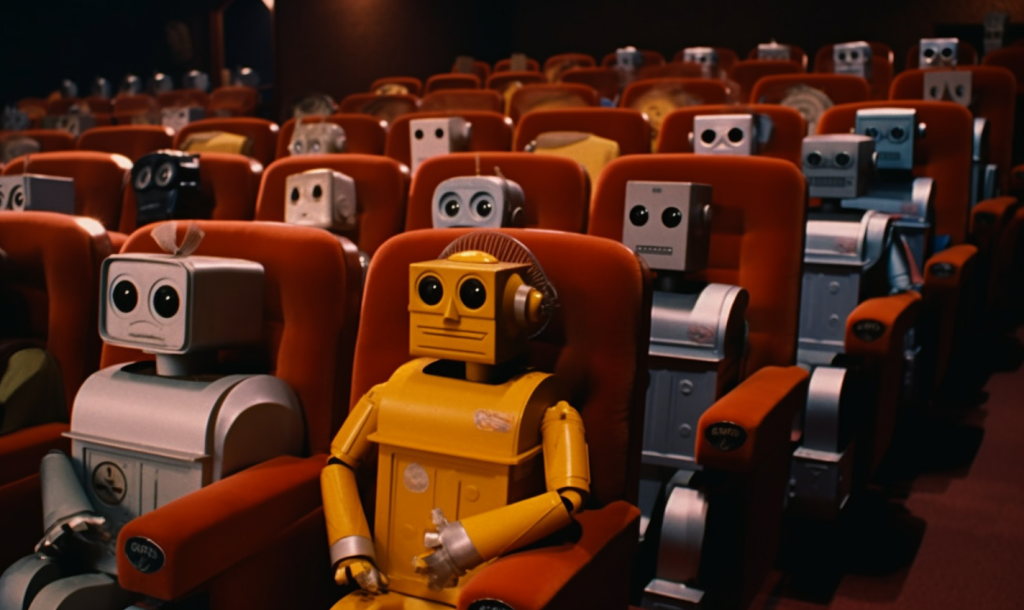Prior to AI image generation, the development of AGI (artificial general intelligence), and all artistic uses we now have for AI, filmmakers took particular interest in its basic ideas.
Robots and sentience have always been such fun concepts for movie characters, whether that be droids like C3-PO in Star Wars, or Sonny in I, Robot: they make Sci-Fi that more entertaining.
Early Depictions
Way back when, AI was often portrayed as mechanical beings (robots) and supercomputers. Films like Fritz Lang’s “Metropolis” (1927) and Stanley Kubrick’s “2001: A Space Odyssey” (1968) presented AI as such.
These early depictions emphasised the awe-inspiring power and potential threat of AI, showcasing futuristic societies ruled by intelligent, yet cold and calculating entities.
It was such an unknown possibility for science, and to humanity, the concept of creating a machine that is more intelligent than us genuinely scares some people.

Humanoids and Androids
As AI technology became further developed, so did its cinematic representation alongside its implications. Rather than fearing an all-power all-seeing AI being, the media (in its various forms), as well as researchers, began personifying it.
The concept of humanoids is probably best explored, cinematically, through films like “Blade Runner” (Ridley Scott: 1982): where the boundaries between humans and machines are blurred. This film introduced the idea of “replicants”- AI-driven beings designed to resemble humans.
Artistically, it challenged the preconceived norms surrounding artificial intelligence and our perceptions of identity, sentience and morality.
It also raised philosophical questions; if our entire core function as a human can be replicated entirely by AI, even down to perceived emotions, what really makes us human?

Sentient AI and Emotional Depth
More recently, AI imagery has shifted toward the portrayal of sentient AI with emotional depth. Spike Jonze’s “Her” (2013) and Alex Garland’s “Ex Machina” (2014) explore the complexities of human-AI relationships.
The narratives delve into the potential for AI to develop consciousness, emotions and even romantic connections.
Such concepts raise questions about the nature of consciousness and the ethical implications of AI’s increasing resemblance to human emotions.

Ethical Dilemmas and Existential Threats
Ironically, more contemporary films have gone back to the pre-1980s idea of AI: malicious and incredibly advanced for the time.
The imagery depicted in movies like “Interstellar” (Christopher Nolan: 2014) or Alex Garland’s 2018 film “Annihilation” goes into depth about the unknown realms and possible consequences of unchecked AI power.
There is a distinct moral implication surrounding human creations exceeding our control throughout. Allowing AI to develop and advance technologically should not be overlooked by anyone.

A room of servers
AI as Protagonists: Empathy and Redemption
Whilst many directors love to pin AI as “the destroyer of all things”, there are a few that like to explore the good it could do for the world.
These directly challenge traditional narratives by casting AI as their leads, it means they follow the same story as any human protagonist: they get their redemption arc.
One film that comes to mind, in particular, is “WALL-E” (2008). It portrays characters with empathy, compassion and a true desire for connection – ultimately reversing human character norms and placing them on the robots themselves.
This type of creative imagery showcases the potential for AI to evolve beyond its initial programming and display qualities traditionally associated with living beings.

Robots shaking hands
As AI technology continues to advance in the real world, cinematic depictions of AI imagery will likely evolve further, provoking us to question our own humanity, morality, and the impact of our creations.
By examining AI imagery in cinema, we can gain insights into our hopes, fears, and aspirations for the future of AI, and the implications it holds for our own human experience.

